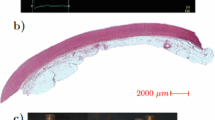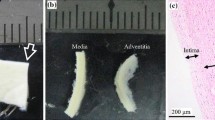Abstract
Rupture properties of thoracic aortic aneurysms (TAAs) were measured in vitro in a pressure-imposed test to predict the ultimate stress of TAAs from their mechanical behavior in a physiological pressure range. Each quadrilateral (ca. 20 × 20 mm2) specimen of TAAs or porcine thoracic aortas (PTAs) was pressurized from the inner wall until rupture or up to 4500 mmHg, while its deformation was being monitored. In-plane stress σ and strain ε of the specimen were calculated using Laplace’s law and deformations of the markers drawn on the specimen surface, respectively. Ultimate stress σ max and tangent elastic modulus H were determined from the σ–ε curve as its maximum stress and slope, respectively. The tangent elastic modulus H of PTA specimens tended to increase with the increase in σ, while that of TAA specimens tended to reach a plateau in a low-σ region. This tendency was confirmed by fitting a function H = C σ (1 − exp(−σ/τ σ )) to the H−σ relation of specimens: The yielding parameter τ σ was significantly lower in TAAs than PTAs. Furthermore, the logarithm of the parameter τ σ correlated significantly with σ max, for all specimens. These results may indicate that τ σ is one of the candidate indices for rupture risk estimation.








Similar content being viewed by others
References
Cambria, R. A., P. Gloviczki, A. W. Stanson, K. J. Cherry, Jr., T. C. Bower, J. W. Hallett, Jr., et al. Outcome and expansion rate of 57 thoracoabdominal aortic aneurysms managed nonoperatively. Am. J. Surg. 170(2):213–217, 1995.
Canham, P. B., H. M. Finlay, J. G. Dixon, and S. E. Ferguson. Layered collagen fabric of cerebral aneurysms quantitatively assessed by the universal stage and polarized light microscopy. Anat. Rec. 231(4):579–592, 1991.
Coady, M. A., J. A. Rizzo, G. L. Hammond, D. Mandapati, U. Darr, G. S. Kopf, et al. What is the appropriate size criterion for resection of thoracic aortic aneurysms? J. Thorac. Cardiovasc. Surg. 113(3):476–491, 1997.
Darling, R. C., C. R. Messina, D. C. Brewster, and L. W. Ottinger LW. Autopsy study of unoperated abdominal aortic aneurysms. The case for early resection. Circulation 56(3):II161–Ii164, 1977.
Fillinger, M. F., M. L. Raghavan, S. P. Marra, J. L. Cronenwett, and F. E. Kennedy. In vivo analysis of mechanical wall stress and abdominal aortic aneurysm rupture risk. J. Vasc. Surg. 36(3):589–597, 2002.
Fukui, T., T. Matsumoto, T. Tanaka, T. Ohashi, K. Kumagai, H. Akimoto, et al. In vivo mechanical properties of thoracic aortic aneurysmal wall estimated from in vitro biaxial tensile test. Biomed. Mater. Eng. 15(4):295–305, 2005.
Groenink, M., S. E. Langerak, E. Vanbavel, E. E. van der Wall, B. J. Mulder, A. C. van der Wal, et al. The influence of aging and aortic stiffness on permanent dilation and breaking stress of the thoracic descending aorta. Cardiovasc. Res. 43(2):471–480, 1999.
Johansson, G., U. Markstrom, and J. Swedenborg. Ruptured thoracic aortic aneurysms: a study of incidence and mortality rates. J. Vasc. Surg. 21(6):985–988, 1995.
Kato, Y., T. Matsumoto, K. Kumagai, H. Akimoto, K. Tabayashi, and M. Sato. Development of a simple method to construct finite element models of aortas from MRI images and its application to thoracic aortic aneurysm. JSME Int. J. Ser. C 43(4):787–794, 2000.
Li, W. C., M. H. Yu, H. M. Zhang, H. Q. Wang, G. M. Xi, B. C. Yao, et al. Biomechanical properties of ascending aorta and pulmonary trunk in pigs and humans. Xenotransplantation 15(6):384–389, 2008.
Matsumoto, T., T. Fukui, T. Tanaka, N. Ikuta, T. Ohashi, K. Kumagai, et al. Biaxial tensile properties of thoracic aortic aneurysm tissues. J. Biomech. Sci. Eng. 4(4):518–529, 2009.
Ohashi, T., T. Matsumoto, H. Abe, T. Aoki, and M. Sato. Intramural distribution of local elastic moduli in bovine thoracic aorta measured by pipette aspiration method. J. Cell Eng. 2(1):12–18, 1997.
Ohashi, T., S. Sugita, T. Matsumoto, K. Kumagai, H. Akimoto, K. Tabayashi, et al. Rupture properties of blood vessel walls measured by pressure-imposed test. JSME Int. J. Ser. C 46(4):1290–1296, 2003.
Okamoto, R. J., J. E. Wagenseil, W. R. DeLong, S. J. Peterson, N. T. Kouchoukos, and T. M. Sundt, 3rd. Mechanical properties of dilated human ascending aorta. Ann. Biomed. Eng. 30(5):624–635, 2002.
Raghavan, M. L., D. A. Vorp, M. P. Federle, M. S. Makaroun, and M. W. Webster. Wall stress distribution on three-dimensionally reconstructed models of human abdominal aortic aneurysm. J. Vasc. Surg. 31(4):760–769, 2000.
Raghavan, M. L., M. W. Webster, and D. A. Vorp. Ex vivo biomechanical behavior of abdominal aortic aneurysm: assessment using a new mathematical model. Ann. Biomed. Eng. 24(5):573–582, 1996.
Stemper, B. D., N. Yoganandan, M. R. Stineman, T. A. Gennarelli, J. L. Baisden, and F. A. Pintar. Mechanics of fresh, refrigerated, and frozen arterial tissue. J. Surg. Res. 139(2):236–242, 2007.
Sterpetti, A. V., A. Cavallaro, N. Cavallari, P. Allegrucci, A. Tamburelli, F. Agosta, et al. Factors influencing the rupture of abdominal aortic aneurysms. Surg. Gynecol. Obstet. 173(3):175–178, 1991.
Svensjo, S., H. Bengtsson, and D. Bergqvist. Thoracic and thoracoabdominal aortic aneurysm and dissection: an investigation based on autopsy. Br. J. Surg. 83(1):68–71, 1996.
The Population Survey Report 2007–2008 [database on the Internet]. Ministry of Health, Labor and Welfare, Japan. 2008. Accessed March 1, 2010, from http://www.mhlw.go.jp.
The Population Survey Report 2008–2009 [database on the Internet]. Ministry of Health, Labor and Welfare, Japan. 2009. Accessed March 1, 2010, from http://www.mhlw.go.jp.
Wilson, K. A., A. J. Lee, P. R. Hoskins, F. G. Fowkes, C. V. Ruckley, and A. W. Bradbury. The relationship between aortic wall distensibility and rupture of infrarenal abdominal aortic aneurysm. J. Vasc. Surg. 37(1):112–117, 2003.
Acknowledgments
The authors thank patients who allowed us to use their aneurysm specimens. The present study was supported in part by Grants-in-Aid for Young Scientists (B) from the Ministry of Education, Culture, Sports, Science and Technology (MEXT) of Japan (No. 22700467) and the Science and Technology Promotion Adjustment Cost Program from the Japan Science and Technology Agency.
Conflict of interest
The authors have no financial and personal relationships with the other people or organizations that could inappropriately influence our work.
Author information
Authors and Affiliations
Corresponding author
Additional information
Associate Editor Tim McGloughlin oversaw the review of this article.
Electronic supplementary material
Below is the link to the electronic supplementary material.
Rights and permissions
About this article
Cite this article
Sugita, S., Matsumoto, T., Ohashi, T. et al. Evaluation of Rupture Properties of Thoracic Aortic Aneurysms in a Pressure-Imposed Test for Rupture Risk Estimation. Cardiovasc Eng Tech 3, 41–51 (2012). https://doi.org/10.1007/s13239-011-0067-1
Received:
Accepted:
Published:
Issue Date:
DOI: https://doi.org/10.1007/s13239-011-0067-1




